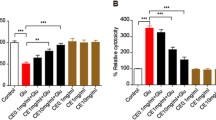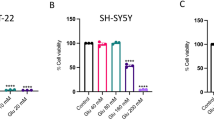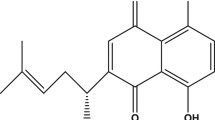Abstract
Thymoquinone (TQ), a bioactive constituent of Nigella sativa Linn (N. sativa) has demonstrated several neuropharmacological attributes. In the present study, the neuroprotective properties of TQ were investigated by studying its anti-apoptotic potential to diminish β-amyloid peptide 1–40 sequence (Aβ1–40)-induced neuronal cell death in primary cultured cerebellar granule neurons (CGNs). The effects of TQ against Aβ1–40-induced neurotoxicity, morphological damages, DNA condensation, the generation of reactive oxygen species, and caspase-3, -8, and -9 activation were investigated. Pretreatment of CGNs with TQ (0.1 and 1 μM) and subsequent exposure to 10 μM Aβ1–40 protected the CGNs against the neurotoxic effects of the latter. In addition, the CGNs were better preserved with intact cell bodies, extensive neurite networks, a loss of condensed chromatin and less free radical generation than those exposed to Aβ1–40 alone. TQ pretreatment inhibited Aβ1–40-induced apoptosis of CGNs via both extrinsic and intrinsic caspase pathways. Thus, the findings of this study suggest that TQ may prevent neurotoxicity and Aβ1–40-induced apoptosis. TQ is, therefore, worth studying further for its potential to reduce the risks of developing Alzheimer’s disease.





Similar content being viewed by others
Abbreviations
- Aβ:
-
Beta-amyloid peptide
- AD:
-
Alzheimer’s disease
- TQ:
-
Thymoquinone
- CGNs:
-
Primary cultured cerebellar granule neurons
- PC12:
-
Pheochromocytoma
- MTS:
-
3-(4,5-Dimethylthiazol-2-yl)-5-(3-carboxymethoxyphenyl)-2-(4-sulfophenyl)-2H-tetrazolium
- LDH:
-
Lactate dehydrogenase
- DMSO:
-
Dimethyl sulfoxide
- PBS:
-
Phosphate buffered saline
- DMPO:
-
5,5-Dimethyl-1-pyrroline-1-oxide
References
Akhtar M, Maikiyo AM, Khanam R, Mujeeb M, Aqil M, Najmi AK (2012) Ameliorating effects of two extracts of Nigella sativa in middle cerebral artery occluded rat. J Pharm Bioallied Sci 4:70–75
Akshomoff N, Courchesne E (1992) A new role for the cerebellum in cognitive operations. Behav Neurosci 106:731–738
Appollonio IM, Grafman J, Schwartz V, Massaquoi S, Hallett M (1993) Memory in patients with cerebellar degeneration. Neurology 43:1536–1544
Babazadeh B, Sadeghnia HR, Kapurchal ES, Parsaee H, Nasri S, Zahra TN (2012) Protective effect of Nigella sativa and thymoquinone on serum/glucose deprivation-induced DNA damage in PC12 cells. Avicenna J Phytomed 2:125–132
Bloedel JR, Bracha V (1997) Duality of cerebellar motor and cognitive functions. Int Rev Neurobiol 41:613–634
Boyd-Kimball D, Sultana R, Mohammad HA, Butterfield DA (2005) γ-Glutamylcysteine ethyl ester-induced up-regulation of glutathione protects neurons against Aβ(1-42)-mediated oxidative stress and neurotoxicity: implications for Alzheimer’s disease. J Neurosci Res 79:700–706
Braak H, Braak E, Bohl J, Lang W (1989) Alzheimer’s disease: amyloid plaques in the cerebellum. J Neurol Sci 93:277–287
Bracke-Tolkmitt R, Linden A, Canavan AGM, Rockstroh B, Scholz E, Wessel K, Diener HC (1989) The cerebellum contributes to mental skills. Behav Neurosci 103:442–446
Bush AI, Huang X, Fairlie DP (1999) The possible origin of free radicals from amyloid β-peptides in Alzheimer’s disease. Neurobiol Aging 20:335–337
Colom LV, Castaneda MT, Aleman D, Touhami A (2013) Memantine protects cholinergic and glutamatergic septal neurons from Aβ1–40-induced toxicity. Neurosci Lett 541:54–57
Cummings JL, Cole G (2002) Alzheimer disease. JAMA 287:2335–2338
D’Amelio M, Cavallucci V, Middei S et al (2011) Caspase-3 triggers early synaptic dysfunction in a mouse model of Alzheimer’s disease. Nat Neurosci 14:69–76
Di Matteo V, Pierucci M, Di Giovanni G, Esposito E (2007) Prevention and therapy of neurodegenerative disorders: role of nutritional antioxidants. In: Qureshi GA, Parvez SH (eds) Oxidative stress and neurodegenerative disorders. Elsevier, Amsterdam, pp 621–661
El-Agamy DS, Nader MA (2012) Attenuation of oxidative stress-induced vascular endothelial dysfunction by thymoquinone. Exp Biol Med 237:1032–1038
Fatokun AA, Stone TW, Smith RA (2007) Cell death in rat cerebellar granule neurons induced by hydrogen peroxide in vitro: mechanisms and protection. Brain Res 1132:93–202
Ferrari CKB (2007) Diet, herbs, and nutritional protection against oxidative stress in neurological diseases. In: Qureshi GA, Parvez SH (eds) Oxidative stress and neurodegenerative disorders. Elsevier, Amsterdam, pp 525–541
Forloni G, Chiesa R, Smiroldo S, Verga L (1993) Apoptosis-mediated neurotoxicity neurotoxicity induced by chronic application of beta amyloid fragment 25–35. Neuroreport 4:523–526
Hardy JA, Higgins GA (1992) Alzheimer’s disease: the amyloid cascade hypothesis. Science 256:184–185
Hirohata M, Ono K, Jun-ichi T, Takahashi R, Ikeda T, Morinaga A, Yamada M (2012) Anti-amyloidogenic effects of soybean isoflavones in vitro: fluorescence spectroscopy demonstrating direct binding to Aβ monomers, oligomers and fibrils. Biochim Biophys Acta 1822:1316–1324
Ikonomovic S, Kharlamov E, Manev H, Ikonomovic MD, Grayson DR (1997) GABA and NMDA in the prevention of apoptotic-like cell death in vitro. Neurochem Int 31:83–290
Irie Y, Keung WM (2003) Rhizoma acori graminei and its active principles protect PC-12 cells from the toxic effect of amyloid-[beta] peptide. Brain Res 963:282–289
Ismail N, Ismail M, Latiff LA, Mazlan M, Mariod AA (2008) Black cumin seed (Nigella sativa Linn.) oil and its fractions protect against beta-amyloid peptide-induced toxicity in primary cerebellar granule neurons. J Food Lipids 15:519–533
Ivins K, Thornton P, Rohn T, Cotman C (1999) Neuronal apoptosis induced by β-amyloid is mediated by caspase-8. Neurobiol Dis 6:440–449
Ivry R, Baldo J (1992) Is the cerebellum involved in learning and cognition? Curr Opin Neurobiol 2:212–216
Joachim CL, Morris JH, Selkoe DJ (1989) Diffuse senile plaques occur commonly in the cerebellum in Alzheimer’s disease. Am J Pathol 135:309–319
Kalashnikova LA, Zueva YV, Pugacheva OV, Korsakova NK (2005) Cognitive impairments in cerebellar infarcts. Neurosci Behav Physiol 35:773–779
Kannan K, Jain SK (2000) Oxidative stress and apoptosis. Pathophysiology 7:153–163
Khan A, Vaibhav K, Javed H, Khan MM, Tabassum R, Ahmed ME et al (2012) Attenuation of Aβ-induced neurotoxicity by thymoquinone via inhibition of mitochondrial dysfunction and oxidative stress. Mol Cell Biochem 369:55–65
Klein JA, Ackerman SL (2003) Oxidative stress, cell cycle, and neurodegeneration. J Clin Invest 111:785–793
Li G, Ma R, Huang C et al (2008) Protective effect of erythropoietin on β-amyloid-induced PC12 cell death through antioxidant mechanisms. Neurosci Lett 442:143–147
Li W, Chu Y, Zhang L, Yin L, Li L (2012) Ginsenoside Rg1 prevents SK-N-SH neuroblastoma cell apoptosis induced by supernatant from Aβ1–40-stimulated THP-1 monocytes. Brain Res Bull 88:501–506
Mann DM, Pickering-Brown SM, Takeuchi A, Iwatsubo T (2001) Amyloid angiopathy and variability in amyloid beta deposition is determined by mutation position in presenilin-1-linked Alzheimer’s disease. Am J Pathol 158:2165–2175
Miguel-Hidalgo JJ, Paul IA, Wanzo V, Banerje PK (2012) Memantine prevents cognitive impairment and reduces Bcl-2 and caspases 8 immunoreactivity in rats injected with amyloid β1–40. Eur J Pharmacol 692:38–45
Ono K, Hasegawa K, Naiki H, Yamada M (2005) Preformed β-amyloid fibrils are destabilized by coenzyme Q10 in vitro. Biochem Biophys Res Comm 330:111–116
Ono K, Hasegawa K, Naiki H, Yamada M (2006) Anti-Parkinsonian agents have anti-amyloidogenic activity for Alzheimer’s β-amyloid fibrils in vitro. Neurochem Int 48:275–285
Ono K, Li L, Takamura Y, Yoshiike Y, Zhu L, Han F, Mao X, Ikeda T, Jun-ichi T, Nishijo H, Takashima A, Teplow DB, Zagorski MG, Yamada M (2012) Phenolic compounds prevent amyloid β-protein oligomerization and synaptic dysfunction by site-specific binding. J Biol Chem 287:14631–14643
Parkins EJ (1997) Cerebellum and cerebrum in adaptive control and cognition: a review. Biol Cybern 77:79–87
Petersen SE, Fiez JA (1993) The processing of single words studied with positron emission tomography. Annu Rev Neurosci 16:509–530
Pieri M, Amadoro G, Carunchio I, Ciotti MT, Quaresima S, Florenzano F, Calissano P, Possenti R, Zona C, Severini C (2010) SP protects cerebellar granule cells against b-amyloid-induced apoptosis by down-regulation and reduced activity of Kv4 potassium channels. Neuropharmacology 58:268–276
Pike CJ, Walencewicz-Wasserman AJ, Kosmoski J, Cribbs DH, Glabe CG, Cotman CW (1995) Structure–activity analyses of beta-amyloid peptides: contributions of the beta 25–35 region to aggregation and neurotoxicity. J Neurochem 64:253–265
Rohn TT, Head E, Nesse WH, Cotman CW, Cribbs DH (2001) Activation of caspase-8 in the Alzheimer’s disease brain. Neurobiol Dis 8:1006–1016
Rohn TT, Wirawan E, Brown RJ, Harris JR, Masliah E, Vandenabeele P (2011) Depletion of Beclin-1 due to proteolytic cleavage by caspases in the Alzheimer’s disease brain. Neurobiol Dis 43:68–78
Scorziello A, Meucci O, Florio T, Fattore M, Forloni G, Salmona M, Schettini G (1996) Beta 25–35 alters calcium homeostasis and induces neurotoxicity in cerebellar granule cells. J Neurochem 66:1995–2003
Selkoe DJ (2001) Alzheimer’s disease results from the cerebral accumulation and cytotoxicity of amyloid beta-protein. J Alzheimers Dis 3:75–80
Sheikh BY, Mohamadin AM (2012) Thymoquinone a potential therapy for cerebral oxidative stress. Asian J Nat Appl Sci 1:76–92
Shrivastava RM, Agrawal RC, Parveen ZJ (2011) A review on therapeutic applications of Nigella sativa. J Chem Chem Sci 1:241–248
Tabner BJ, Turnbull S, El-Agnaf OMA, Allsop D (2002) Formation of hydrogen peroxide and hydroxyl radicals from Aβ and α-synuclein as a possible mechanism of cell death in Alzheimer’s disease and Parkinson’s disease. Free Radic Biol Med 32:1076–1083
Tacconi S, Perri R, Balestrieri E et al (2004) Increased caspase activation in peripheral blood mononuclear cells of patients with Alzheimer’s disease. Exp Neurol 190:254–262
Terry AV Jr, Callahan PM, Hall B, Webster SJ (2011) Alzheimer’s disease and age-related memory decline (preclinical). Pharmacol Biochem Behav 99:190–210
Ullah I, Ullah N, Naseer MI, Lee HY, Kim MO (2012) Neuroprotection with metformin and thymoquinone against ethanol-induced apoptotic neurodegeneration in prenatal rat cortical neurons. BMC Neurosci 13:11
Wai MS, Liang Y, Shi C, Cho EY, Kung HF, Yew DT (2009) Co-localization of hyperphosphorylated tau and caspase in the brainstem of Alzheimer’s disease patients. Biogerontology 10:457–469
Wallesch CW, Horn A (1990) Long-term effects of cerebellar pathology on cognitive functions. Brain Cogn 14:19–25
Wan B, Hu X, Nie J, Zhou M, Yang B, Li Y, Wen W, Lu C (2013) Effects of triptolide on degeneration of dendritic spines induced by Aβ1–40 injection in rat hippocampus. Neurol Sci. doi:10.1007/s10072-013-1463-0
Wegiel J, Wisniewski HM, Dziewiatkowski J, Badmajew E, Tarnawski M, Reisberg B, Mlodzik B, Miller DC (1999) Cerebellar atrophy in Alzheimer’s disease-clinicopathological correlations. Brain Res 818:41–50
Wei H, Leeds PR, Qian Y, Wei W, Chen R, Chuang D (2000) β-Amyloid peptide-induced death of PC 12 cells and cerebellar granule cell neurons is inhibited by long-term lithium treatment. Eur J Pharmacol 392:117–123
Yamaguchi H, Hirai S, Morimatsu M, Shoji M, Nakazato Y (1989) Diffuse type of senile plaques in the cerebellum of Alzheimer-type dementia demonstrated by β protein immunostain. Acta Neuropathol 77:314–319
Yankner BA (1996) Mechanisms of neuronal degeneration in Alzheimer’s disease. Neuron 16:921–932
Yankner BA, Dawes LR, Fisher S, Vilia-Komaroff L, Oster-Granite ML, Neve RL (1989) Neurotoxicity of a fragment of amyloid precursor associated with Alzheimer’s disease. Science 245:417–420
Yu MS, Leung SKY, Lai SW et al (2005) Neuroprotective effects of anti-aging oriental medicine Lycium barbarum against β-amyloid peptide neurotoxicity. Exp Gerontol 40:716–727
Zhang J, Zhen YF, Pu-Bu-Ci-Ren, Song LG, Kong WN, Shao TM, Li X, Chai XQ (2013) Salidroside attenuates beta amyloid-induced cognitive deficits via modulating oxidative stress and inflammatory mediators in rat hippocampus. Behav Brain Res 244:70–81
Acknowledgments
Authors are thankful to Government of Malaysia and Universiti Putra Malaysia for providing financial support for this work via Research University Grant.
Conflict of interests
None of the authors have any conflict of interest.
Author information
Authors and Affiliations
Corresponding author
Rights and permissions
About this article
Cite this article
Ismail, N., Ismail, M., Mazlan, M. et al. Thymoquinone Prevents β-Amyloid Neurotoxicity in Primary Cultured Cerebellar Granule Neurons. Cell Mol Neurobiol 33, 1159–1169 (2013). https://doi.org/10.1007/s10571-013-9982-z
Received:
Accepted:
Published:
Issue Date:
DOI: https://doi.org/10.1007/s10571-013-9982-z




